Search Results for Tag: research
Antarctic Peninsula is thawing faster
Ice in parts of the Antarctic Peninsula is now melting during the summer faster than at any time during the last thousand years, according to new research results. The scientists have reconstructed changes in the intensity of ice-melt, and the mean temperature on the northern Antarctic Peninsula since AD 1000, based on the analysis of ice cores.
According to the study, published in the journal Nature Geoscience, the coolest conditions and lowest melt occurred from about AD 1410 to 1460, when mean temperature was 1.6 °C lower than that of 1981–2000. Since the late 1400s, there has been a nearly tenfold increase in melt intensity from 0.5 to 4.9%. The warming has occurred in progressive phases since about AD 1460, but the melting has intensified, and has largely occurred since the mid-twentieth century. The study concludes that “ice on the Antarctic Peninsula is now particularly susceptible to rapid increases in melting and loss in response to relatively small increases in mean temperature”.
Paul Brown of Climate News Network says the findings explain a series of sudden collapses of ice shelves in the last 20 years, which scientists studying them had not expected. He also quotes the researchers as saying the current melting could lead to “further dramatic events, making the loss of large quantities of ice on the Peninsula more likely, and adding to sea level rise”.
The study is also of interest against the background of the debate going on over the last 20 years on whether the Antarctic would gain mass through extra snow falling and so REDUCE sea level rise, or would lose ice because of higher sea and air temperature and so exacerbate the effect.
The scientists use a 364-metre ice core from James Ross Island to get in insight into both past temperatures and ice melt. Layers in the core show periods when summer snow on the ice cap thawed and then refroze. By measuring the thickness of the layers, they could tell how the history of the melting related to changes in temperature at the site over the last thousand years.
Lead author Dr. Nerilie Abram of the Australian National University and the British Antarctic Survey (BAS) said: “Summer melting at the ice core site today is now at a level that is higher than at any other time over the last 1,000 years. And whilst temperatures at this site increased gradually in phases over many hundreds of years, most of the intensification of melting has happened since the mid-20th centrtury.
Dr. Robert Mulvaney from the BAS, who led the drilling expedition and co-authored the paper said: “Having a record of previous melt intensity for the Peninsula is particularly important because of the glacier retreat and ice shelf loss we are now seeing in the area. Summer ice melt is a key process that is thought to have weakened ice shelves along the Antarctic Pensinsula leading to a succession of dramatic collapses, as well as speeding up glacier ice loss across the region over the last 50 years”.
The changes on the Antarctic Peninsula do not necessarily apply to other parts of Antarctica, such as the West Antarctic ice Sheet. Melting is also occurring there and could have an even greater risk of large-scale sea level rise.
Paul Brown from Climate News Network notes “it is not clear that the levels of recent ice melt and glacier loss in West Antarctica are exceptional or are caused by human-driven climate changes.”
Lead author Abram says: “This new ice core record shows that even small changes in temperature can result in large increases in the amount of melting in places where summer tempearatures are near to 0°C, such as along the Antarctic Peninsula, and this has important implications for ice instability and sea level rise in a warming climate”.
I interviewed Andrew Shepherd, Professor of Earth Observation at the British University of leeds, on a major satellite sutdy of the polar ice melt towards the end of last year. It makes interesting listening to complement this latest development:
Interview with Andrew Shepherd
See also:
Polar ice sheets melting faster than ever
Are warming seas changing the Antarctic ice?
Photo gallery: High season for Antarctic researchers
Greener Arctic will speed up warming
New research predicts that rising temperatures will lead to a massive “greening” or increase in plant cover in the Arctic. In a paper published in Nature Climate Change on March 31st, scientists present new models projecting that wooded areas in the Arctic could increase by as much as 50 percent over the next few decades. They also show that this will accelerate climate warming at a faster rate than previously expected.
In the Ice Blog post of March 11th, A Greener Arctic in a Warmer Climate, I wrote about a study of satellite data showing there have already been considerable changes, with plants growing further north and reaching higher heights than previously in their present locations. The new work, funded by the National Science Foundation, models how the “greening” of the Arctic could continue and what effects it could have.
Richard Pearson, the lead author on the paper and a scientist at the American Museum of natural History’s Center for Biodiversity and Conservation says “such widespread redistribution of Arctic vegetation would have impacts that reverberate through the global ecosystem”. Once again, we have a piece of research demonstrating the worldwide significance of what is happening in the far north of the planet.
The models suggest there could be trees growing hundreds of miles north of the present tree line in Siberia. As well as changing living conditions for flora and fauna, the researchers draw particular attention to the feedback effects which would be produced by having a green rather than a white Arctic. The albedo effect would have the greatest impact, they say. The white snow reflects most of the radiation back to space. “Dark” areas, on the other hand, in this case trees or shrubs, would absorb more sunlight, leading to a further increase in temperature. For the Arctic, that would mean “the more vegetation there is, the more warming will occur”, according to the study. It is the same phenomenon observed when the increased melting of the sea ice gives way to darker water, which absorbs more heat.
You might wonder if the plant growth could offset this warming effect by absorbing atmospheric carbon. But this process happens too slowly for that, says co-author of the study Michael Loranty, from Colgate Unversity.:
“By incorporating observed relationships between plants and albedo, we show that vegetation distribution shifts will result in an overall positive feedback to climate that is likely to cause greater warming than has previously been predicted”, according to Wood Hole Research Center Senior Scientist Scott Goetz, another co-author.
The temperature in the Arctic is already rising at about twice the global rate.
Climate change causes extreme weather
Human-triggered climate change has been the cause of a lot of the recent extreme weather across the globe, according to a new scientific study. A team from the Potsdam Institute for Climate Impact Research (PIK) says it has found a physical cause common to events such as the 2011 heat waves in the USA, the 2010 Russian heat wave or the floods in Pakistan in the same year. The scientists, whose study is published in the US journal Proceedings of the National Academy of Sciences this week, say climate change is affecting the movement of air around the northern hemisphere, resulting in extreme conditions. Lead author Vladimir Petoukov says: “An important part of the global air movement in the mid-latitudes of the earth normally takes the form of waves travelling around the planet, oscillating between the tropical and the Arctic regions. When they travel upwards, these waves suck warm air from the tropics to Europe, Russia, or the USA; when they dip downwards, they do the same with cold air from the Arctic. We found that during several recent extreme weather events, these waves virtually froze and remained unchanged for weeks. Instead of bringing in cool air after warm air, the heat just stays. ”
The mechanism is a complex one and the report is not easy reading. I can recommend a summary produced by Alex Kirby for the “Climate News Network“.
PIK’s director Hans Joachim Schellnhuber, a co-author of the study, describes it as a breakthrough, but stresses there are other factors involved in extreme weather events as well as climate change. However, he and his colleagues say the physical process they have identified helps to explain the increasing number of weather extremes and provides a mechanism to explain a link between climate change and extreme weather.
USA announces new five-year Arctic Research Plan
The US administration’s National Science and Technology Council has released a plan outlining key areas of study to be taken by the Federal government to better understand and predict environmental changes in the Arctic. The plan was developed by a team of experts representing 14 federal agencies and was based on input from sources including the indigenous Arctic communities, the Alaska Governor’s Office, local organizations and universities. It highlights research areas important for the development of national policies and areas which would benefit from cooperation between various agencies. Amongst the topics identified for focus are regional climate models, human health studies and adaptation tools for communities.
The announcement is a significant one in the view of the US Arctic Research Commission. They say it is “probably the first, truly integrated, five year US Arctic Research Program plan (ever?) released.”
Incidentally, the website of that particular organisation is a useful source for anybody following Arctic developments.
A climate-friendly future? Impressions of Masdar City
Today I paid a visit to Masdar City 17km from the centre of Abu Dhabi, set up in 2006 with the aim of being “one of the most sustainable cities in the world”, according to Masdar. Masdar was set up as a commercially driven renewable energy company and a strategic government initiative. The city is powered entirely by renewable energy and the buildings are designed to maximize energy efficiency.
This is an impression of the iconic architecture of Masdar around a pleasantly cool courtyard. (The modest gentleman on the couch is Sultan Aal Ali, in charge of Masdar’s development).
In the years since the vision of a sustainable, purpose-built city at the heart of a desert state was first launched, a lot of the enthusiasm seemed to have gone out of the project, at least in the view of a lot of media. That is one reason why I was keen to have a look at what is happening there today. I will be writing an article for our website on this in the next couple of weeks, so for today I’d just like to share some pictures, thoughts and impressions with you.
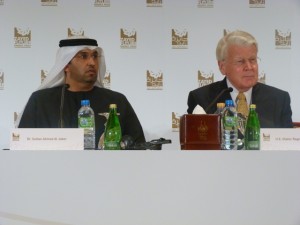
Dr. Sultan Ahmed Al Jaber, Director General of the Zayed Future Energy Prize with President Grimsson
Incidentally, as part of the World Future Energy Summit and at the ceremony announcing the 2013 Zayed Future Energy Prize here last night, the ICE connection was brought up again by the President of Iceland, Olafur Ragran Grimsson.
He was chairman of the prize jury and was talking about those connections between the record melt of the Arctic ice and the push for renewables here in the oil-rich Gulf region. Yes! The message seems to have arrived on the global stage.
Anyway, to Masdar City:
Using the sun to cool Masdar. Normally, air-conditioning would be one of the highest electricity-guzzlers and emissions producers. The architecture uses window-to-wall ratio, insulating building materials, shading and other means to keep buildings cool – and uses sun power to do the rest.
A modern version of a cooling wind-tower, to bring cold air to the courtyard. These towers have a long tradition in the region. They look great as well.
Hi-tech lab for nano-technology research at the Masdar Institute. The city is developing around the university complex.
This is the centre-piece of the brand-new 2nd phase of the Masdar Institute. The city is a work in progress. Today I was one of the first journalists to be allowed into the new development without safety helmet and boots for construction site safety.
Beautiful places, beautiful people! One of my guides from Masdar’s communications department against the background of a wall constructed from desert sand. Thanks!!!
Driverless public transport, using magnetic technology. Felt a little like sci-fi, but definitely got us across the complex. Not sure if it will catch on, but it was quite an experience.
I could go on all night, but will save the rest for a later date. There is plenty of building work going on. The German company Siemens will soon be moving in to its new headquarters in Masdar. Other companies are also planning to move in. The International Renewable Energy Association IRENA will ultimately have its headquarters here.
So far, students are the only residents. Seems a bit extravagant, which is one of the criticisms levelled at the eco-city in the past. But from what I saw today, things seem to be finally moving forward. EU Commissioner Connie Hedegard, who also visited Masdar today, told me Masdar was “leading by example”. She’s very positive about what’s happening in the region in terms of the growing interest in renewables. There’s a long way to go, she says – but stresses that applies to all of us.
Still seats available at this Masdar café today.







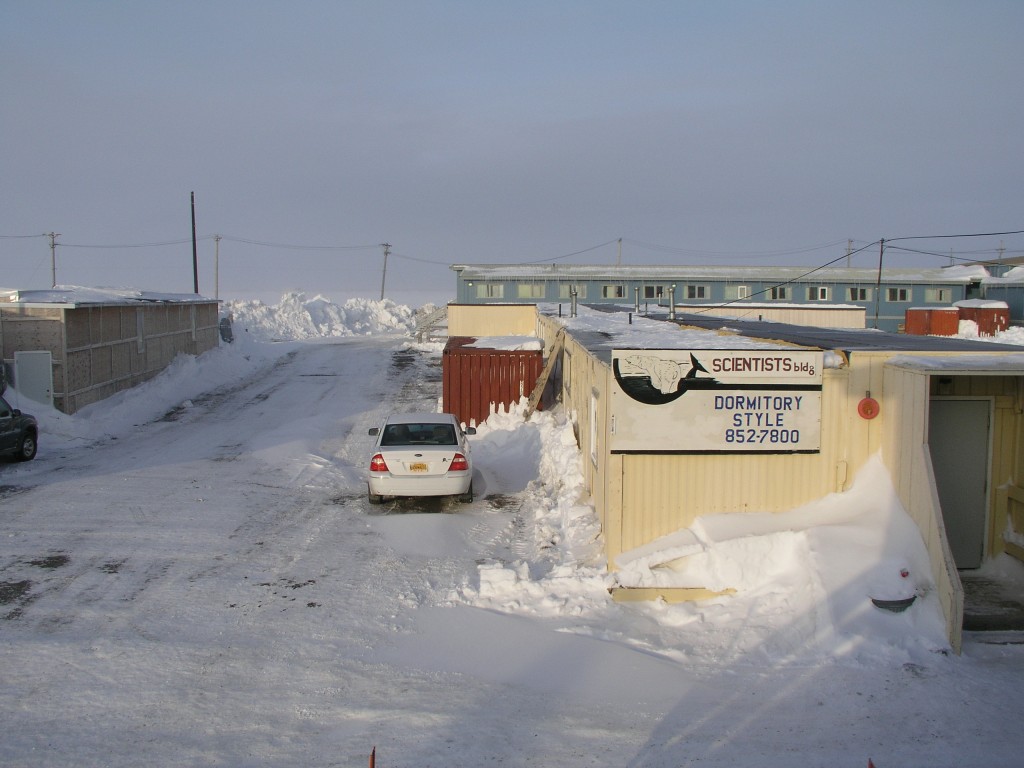


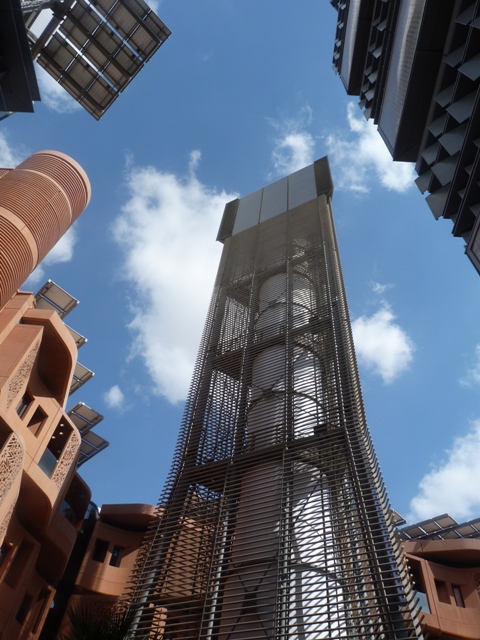

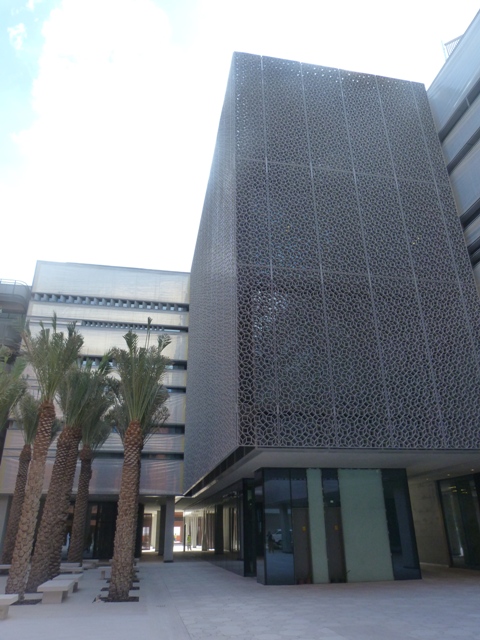
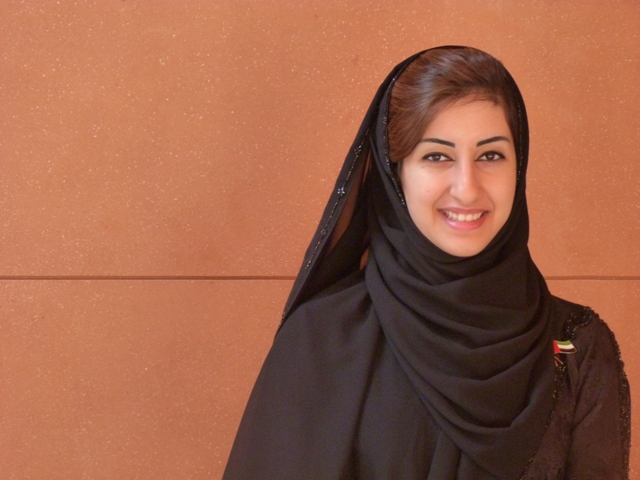

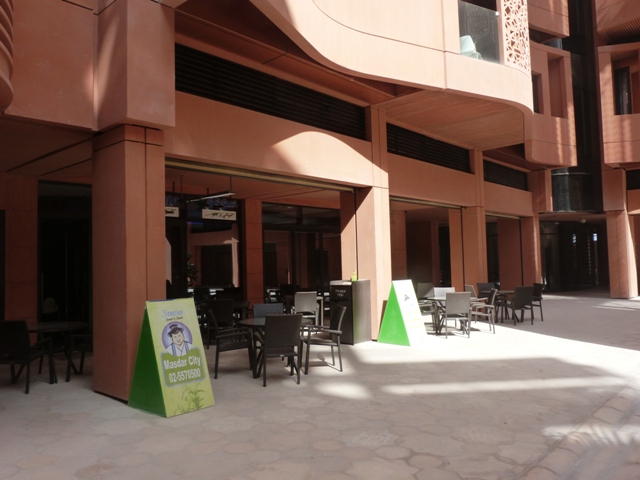
















Feedback